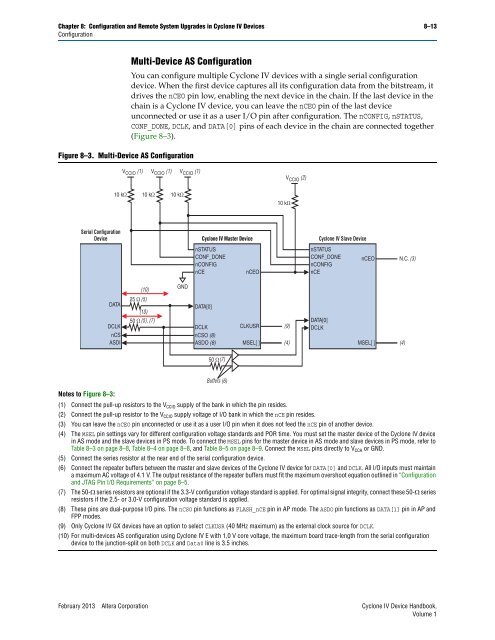Configuration and Remote System Upgrades in Cyclone IV ... - Altera
Configuration and Remote System Upgrades in Cyclone IV ... - Altera
Configuration and Remote System Upgrades in Cyclone IV ... - Altera
Create successful ePaper yourself
Turn your PDF publications into a flip-book with our unique Google optimized e-Paper software.
Chapter 8: <strong>Configuration</strong> <strong>and</strong> <strong>Remote</strong> <strong>System</strong> <strong>Upgrades</strong> <strong>in</strong> <strong>Cyclone</strong> <strong>IV</strong> Devices 8–13<br />
<strong>Configuration</strong><br />
Multi-Device AS <strong>Configuration</strong><br />
Figure 8–3. Multi-Device AS <strong>Configuration</strong><br />
DATA<br />
Notes to Figure 8–3:<br />
DCLK<br />
nCS<br />
ASDI<br />
You can configure multiple <strong>Cyclone</strong> <strong>IV</strong> devices with a s<strong>in</strong>gle serial configuration<br />
device. When the first device captures all its configuration data from the bitstream, it<br />
drives the nCEO p<strong>in</strong> low, enabl<strong>in</strong>g the next device <strong>in</strong> the cha<strong>in</strong>. If the last device <strong>in</strong> the<br />
cha<strong>in</strong> is a <strong>Cyclone</strong> <strong>IV</strong> device, you can leave the nCEO p<strong>in</strong> of the last device<br />
unconnected or use it as a user I/O p<strong>in</strong> after configuration. The nCONFIG, nSTATUS,<br />
CONF_DONE, DCLK, <strong>and</strong> DATA[0] p<strong>in</strong>s of each device <strong>in</strong> the cha<strong>in</strong> are connected together<br />
(Figure 8–3).<br />
V CCIO (1)<br />
V CCIO (1)<br />
10 kΩ 10 kΩ 10 kΩ<br />
Serial <strong>Configuration</strong><br />
Device <strong>Cyclone</strong> <strong>IV</strong> Master Device<br />
<strong>Cyclone</strong> <strong>IV</strong> Slave Device<br />
(10)<br />
25 Ω (5)<br />
(10)<br />
50 Ω (5), (7)<br />
V CCIO (1)<br />
GND<br />
nSTATUS<br />
CONF_DONE<br />
nCONFIG<br />
nCE<br />
DATA[0]<br />
DCLK<br />
nCSO (8)<br />
ASDO (8)<br />
50 Ω (7)<br />
Buffers (6)<br />
nCEO<br />
V CCIO (2)<br />
nSTATUS<br />
CONF_DONE<br />
nCONFIG<br />
nCE<br />
(1) Connect the pull-up resistors to the VCCIO supply of the bank <strong>in</strong> which the p<strong>in</strong> resides.<br />
(2) Connect the pull-up resistor to the VCCIO supply voltage of I/O bank <strong>in</strong> which the nCE p<strong>in</strong> resides.<br />
(3) You can leave the nCEO p<strong>in</strong> unconnected or use it as a user I/O p<strong>in</strong> when it does not feed the nCE p<strong>in</strong> of another device.<br />
(4) The MSEL p<strong>in</strong> sett<strong>in</strong>gs vary for different configuration voltage st<strong>and</strong>ards <strong>and</strong> POR time. You must set the master device of the <strong>Cyclone</strong> <strong>IV</strong> device<br />
<strong>in</strong> AS mode <strong>and</strong> the slave devices <strong>in</strong> PS mode. To connect the MSEL p<strong>in</strong>s for the master device <strong>in</strong> AS mode <strong>and</strong> slave devices <strong>in</strong> PS mode, refer to<br />
Table 8–3 on page 8–8, Table 8–4 on page 8–8, <strong>and</strong> Table 8–5 on page 8–9. Connect the MSEL p<strong>in</strong>s directly to VCCA or GND.<br />
(5) Connect the series resistor at the near end of the serial configuration device.<br />
(6) Connect the repeater buffers between the master <strong>and</strong> slave devices of the <strong>Cyclone</strong> <strong>IV</strong> device for DATA[0] <strong>and</strong> DCLK. All I/O <strong>in</strong>puts must ma<strong>in</strong>ta<strong>in</strong><br />
a maximum AC voltage of 4.1 V. The output resistance of the repeater buffers must fit the maximum overshoot equation outl<strong>in</strong>ed <strong>in</strong> “<strong>Configuration</strong><br />
<strong>and</strong> JTAG P<strong>in</strong> I/O Requirements” on page 8–5.<br />
(7) The 50- series resistors are optional if the 3.3-V configuration voltage st<strong>and</strong>ard is applied. For optimal signal <strong>in</strong>tegrity, connect these 50- series<br />
resistors if the 2.5- or 3.0-V configuration voltage st<strong>and</strong>ard is applied.<br />
(8) These p<strong>in</strong>s are dual-purpose I/O p<strong>in</strong>s. The nCSO p<strong>in</strong> functions as FLASH_nCE p<strong>in</strong> <strong>in</strong> AP mode. The ASDO p<strong>in</strong> functions as DATA[1] p<strong>in</strong> <strong>in</strong> AP <strong>and</strong><br />
FPP modes.<br />
(9) Only <strong>Cyclone</strong> <strong>IV</strong> GX devices have an option to select CLKUSR (40 MHz maximum) as the external clock source for DCLK.<br />
(10) For multi-devices AS configuration us<strong>in</strong>g <strong>Cyclone</strong> <strong>IV</strong> E with 1,0 V core voltage, the maximum board trace-length from the serial configuration<br />
device to the junction-split on both DCLK <strong>and</strong> Data0 l<strong>in</strong>e is 3.5 <strong>in</strong>ches.<br />
February 2013 <strong>Altera</strong> Corporation <strong>Cyclone</strong> <strong>IV</strong> Device H<strong>and</strong>book,<br />
Volume 1<br />
10 kΩ<br />
CLKUSR (9)<br />
DATA[0]<br />
DCLK<br />
nCEO<br />
MSEL[ ] (4) MSEL[ ]<br />
N.C. (3)<br />
(4)
















